Health and Social Care: ICT Benefits, Legislation, Factors
VerifiedAdded on 2021/05/27
|7
|1782
|19
Report
AI Summary
This report provides a comprehensive analysis of the impact of Information and Communication Technology (ICT) on the health and social care industry. It highlights the significant benefits of ICT, such as improved patient care, enhanced communication between healthcare professionals and patients, and increased efficiency in treatment facilities. The report delves into the advantages of electronic health records and the ability of ICT to meet the needs of healthcare professionals and organizations. It also addresses critical factors like the Data Protection Act, strict confidentiality, and patient security, emphasizing the importance of responsible ICT implementation. The conclusion underscores the transformative role of ICT in modern healthcare and the need to consider legal and ethical considerations for optimal patient outcomes.
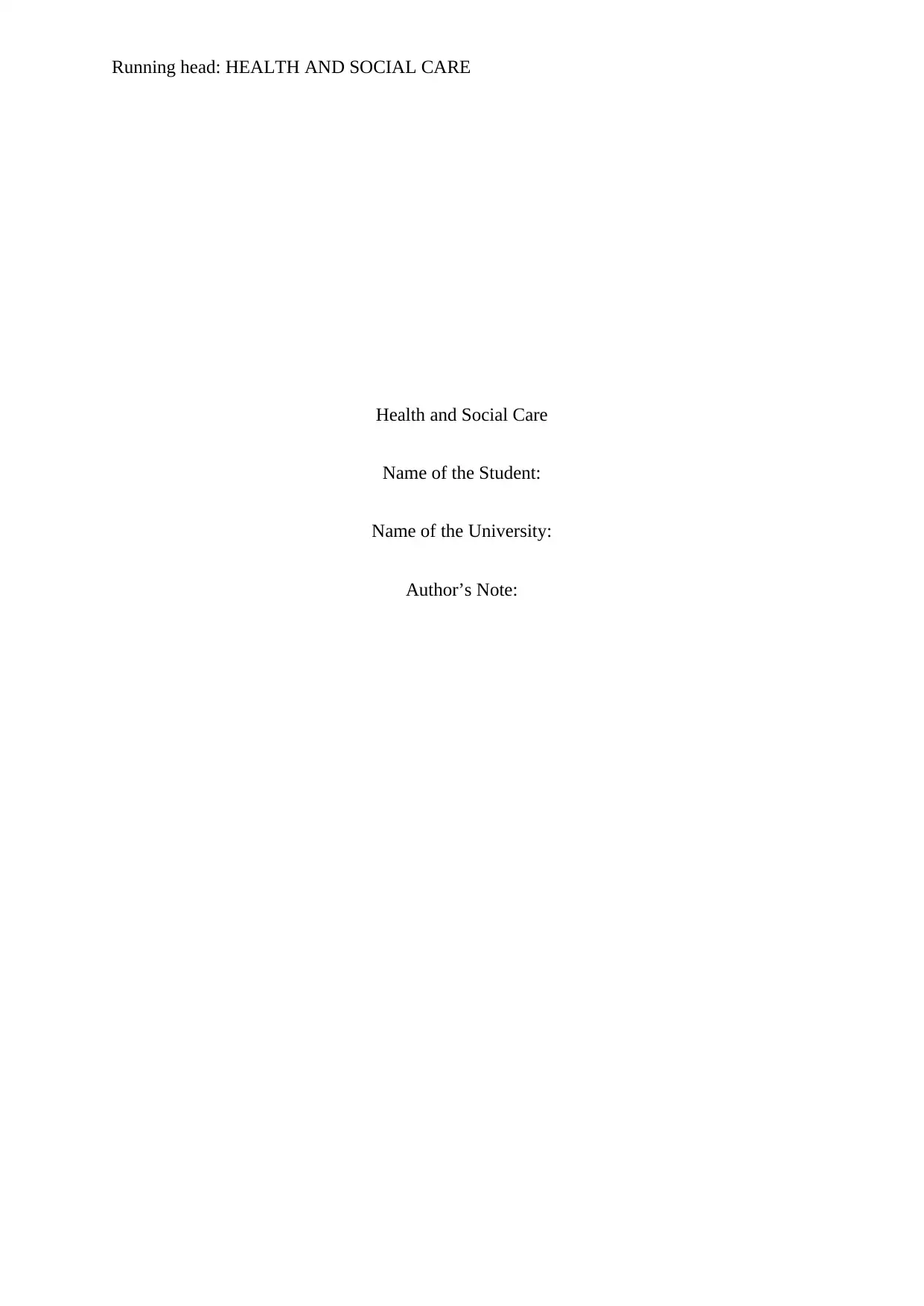
Running head: HEALTH AND SOCIAL CARE
Health and Social Care
Name of the Student:
Name of the University:
Author’s Note:
Health and Social Care
Name of the Student:
Name of the University:
Author’s Note:
Paraphrase This Document
Need a fresh take? Get an instant paraphrase of this document with our AI Paraphraser
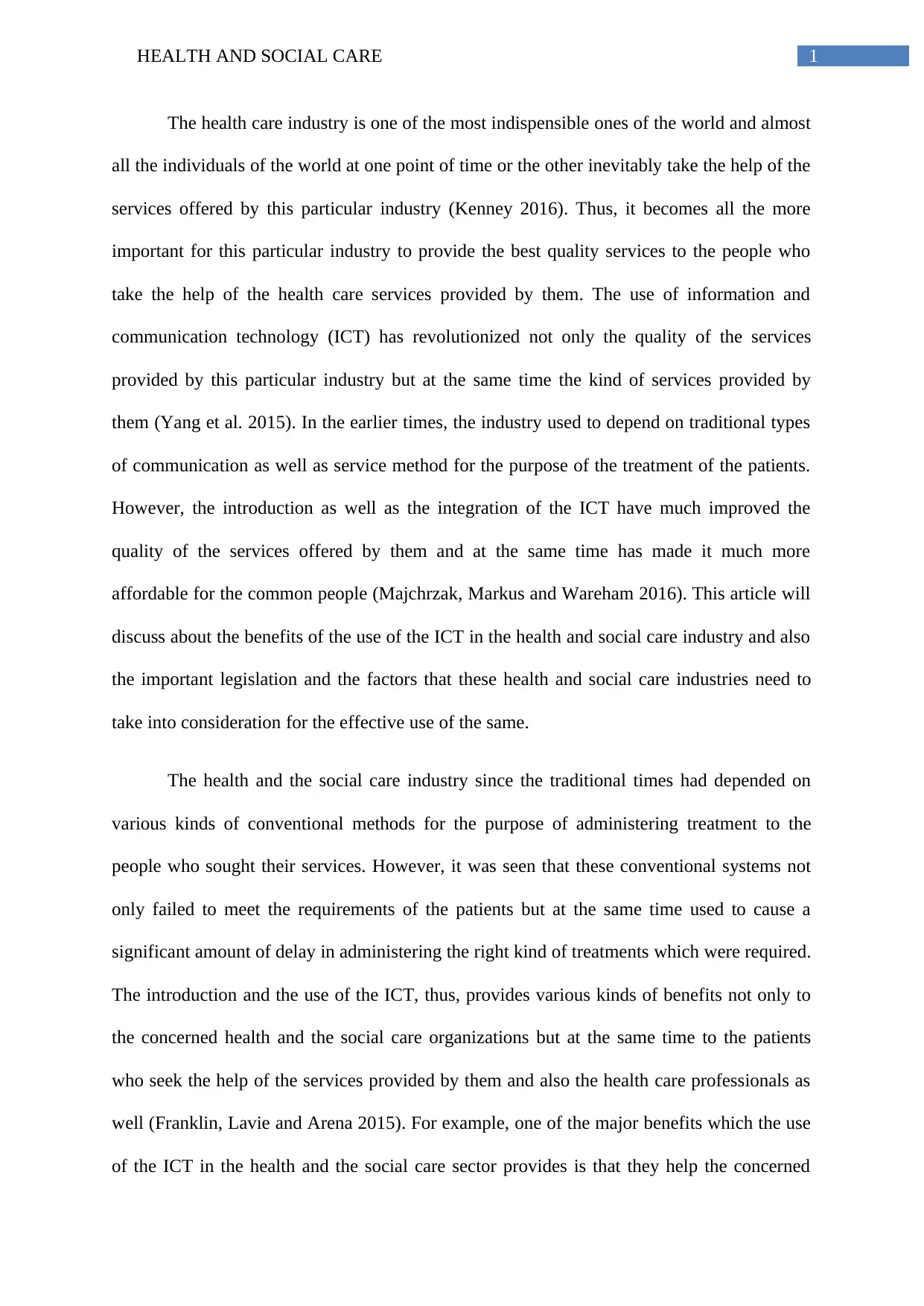
1HEALTH AND SOCIAL CARE
The health care industry is one of the most indispensible ones of the world and almost
all the individuals of the world at one point of time or the other inevitably take the help of the
services offered by this particular industry (Kenney 2016). Thus, it becomes all the more
important for this particular industry to provide the best quality services to the people who
take the help of the health care services provided by them. The use of information and
communication technology (ICT) has revolutionized not only the quality of the services
provided by this particular industry but at the same time the kind of services provided by
them (Yang et al. 2015). In the earlier times, the industry used to depend on traditional types
of communication as well as service method for the purpose of the treatment of the patients.
However, the introduction as well as the integration of the ICT have much improved the
quality of the services offered by them and at the same time has made it much more
affordable for the common people (Majchrzak, Markus and Wareham 2016). This article will
discuss about the benefits of the use of the ICT in the health and social care industry and also
the important legislation and the factors that these health and social care industries need to
take into consideration for the effective use of the same.
The health and the social care industry since the traditional times had depended on
various kinds of conventional methods for the purpose of administering treatment to the
people who sought their services. However, it was seen that these conventional systems not
only failed to meet the requirements of the patients but at the same time used to cause a
significant amount of delay in administering the right kind of treatments which were required.
The introduction and the use of the ICT, thus, provides various kinds of benefits not only to
the concerned health and the social care organizations but at the same time to the patients
who seek the help of the services provided by them and also the health care professionals as
well (Franklin, Lavie and Arena 2015). For example, one of the major benefits which the use
of the ICT in the health and the social care sector provides is that they help the concerned
The health care industry is one of the most indispensible ones of the world and almost
all the individuals of the world at one point of time or the other inevitably take the help of the
services offered by this particular industry (Kenney 2016). Thus, it becomes all the more
important for this particular industry to provide the best quality services to the people who
take the help of the health care services provided by them. The use of information and
communication technology (ICT) has revolutionized not only the quality of the services
provided by this particular industry but at the same time the kind of services provided by
them (Yang et al. 2015). In the earlier times, the industry used to depend on traditional types
of communication as well as service method for the purpose of the treatment of the patients.
However, the introduction as well as the integration of the ICT have much improved the
quality of the services offered by them and at the same time has made it much more
affordable for the common people (Majchrzak, Markus and Wareham 2016). This article will
discuss about the benefits of the use of the ICT in the health and social care industry and also
the important legislation and the factors that these health and social care industries need to
take into consideration for the effective use of the same.
The health and the social care industry since the traditional times had depended on
various kinds of conventional methods for the purpose of administering treatment to the
people who sought their services. However, it was seen that these conventional systems not
only failed to meet the requirements of the patients but at the same time used to cause a
significant amount of delay in administering the right kind of treatments which were required.
The introduction and the use of the ICT, thus, provides various kinds of benefits not only to
the concerned health and the social care organizations but at the same time to the patients
who seek the help of the services provided by them and also the health care professionals as
well (Franklin, Lavie and Arena 2015). For example, one of the major benefits which the use
of the ICT in the health and the social care sector provides is that they help the concerned
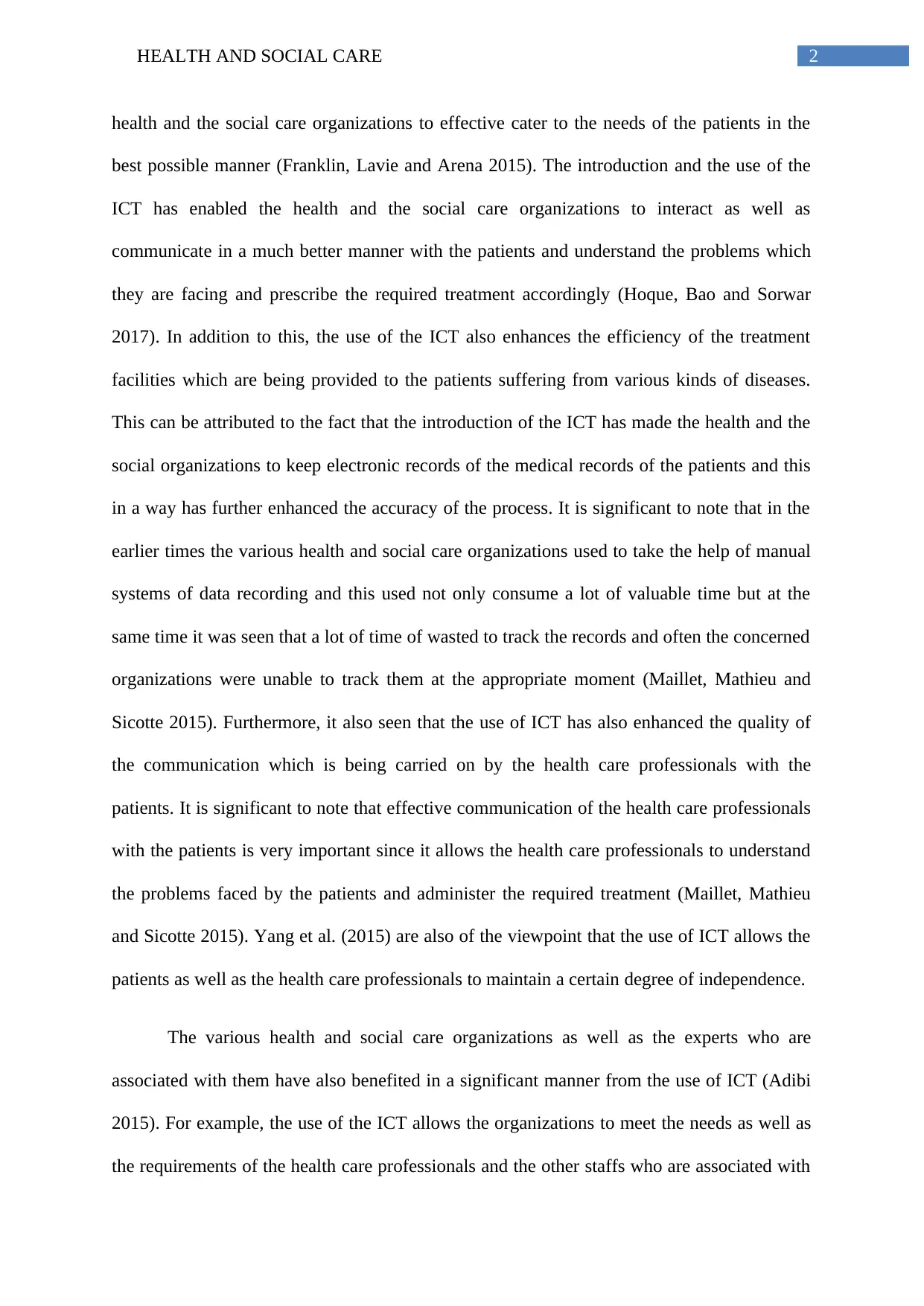
2HEALTH AND SOCIAL CARE
health and the social care organizations to effective cater to the needs of the patients in the
best possible manner (Franklin, Lavie and Arena 2015). The introduction and the use of the
ICT has enabled the health and the social care organizations to interact as well as
communicate in a much better manner with the patients and understand the problems which
they are facing and prescribe the required treatment accordingly (Hoque, Bao and Sorwar
2017). In addition to this, the use of the ICT also enhances the efficiency of the treatment
facilities which are being provided to the patients suffering from various kinds of diseases.
This can be attributed to the fact that the introduction of the ICT has made the health and the
social organizations to keep electronic records of the medical records of the patients and this
in a way has further enhanced the accuracy of the process. It is significant to note that in the
earlier times the various health and social care organizations used to take the help of manual
systems of data recording and this used not only consume a lot of valuable time but at the
same time it was seen that a lot of time of wasted to track the records and often the concerned
organizations were unable to track them at the appropriate moment (Maillet, Mathieu and
Sicotte 2015). Furthermore, it also seen that the use of ICT has also enhanced the quality of
the communication which is being carried on by the health care professionals with the
patients. It is significant to note that effective communication of the health care professionals
with the patients is very important since it allows the health care professionals to understand
the problems faced by the patients and administer the required treatment (Maillet, Mathieu
and Sicotte 2015). Yang et al. (2015) are also of the viewpoint that the use of ICT allows the
patients as well as the health care professionals to maintain a certain degree of independence.
The various health and social care organizations as well as the experts who are
associated with them have also benefited in a significant manner from the use of ICT (Adibi
2015). For example, the use of the ICT allows the organizations to meet the needs as well as
the requirements of the health care professionals and the other staffs who are associated with
health and the social care organizations to effective cater to the needs of the patients in the
best possible manner (Franklin, Lavie and Arena 2015). The introduction and the use of the
ICT has enabled the health and the social care organizations to interact as well as
communicate in a much better manner with the patients and understand the problems which
they are facing and prescribe the required treatment accordingly (Hoque, Bao and Sorwar
2017). In addition to this, the use of the ICT also enhances the efficiency of the treatment
facilities which are being provided to the patients suffering from various kinds of diseases.
This can be attributed to the fact that the introduction of the ICT has made the health and the
social organizations to keep electronic records of the medical records of the patients and this
in a way has further enhanced the accuracy of the process. It is significant to note that in the
earlier times the various health and social care organizations used to take the help of manual
systems of data recording and this used not only consume a lot of valuable time but at the
same time it was seen that a lot of time of wasted to track the records and often the concerned
organizations were unable to track them at the appropriate moment (Maillet, Mathieu and
Sicotte 2015). Furthermore, it also seen that the use of ICT has also enhanced the quality of
the communication which is being carried on by the health care professionals with the
patients. It is significant to note that effective communication of the health care professionals
with the patients is very important since it allows the health care professionals to understand
the problems faced by the patients and administer the required treatment (Maillet, Mathieu
and Sicotte 2015). Yang et al. (2015) are also of the viewpoint that the use of ICT allows the
patients as well as the health care professionals to maintain a certain degree of independence.
The various health and social care organizations as well as the experts who are
associated with them have also benefited in a significant manner from the use of ICT (Adibi
2015). For example, the use of the ICT allows the organizations to meet the needs as well as
the requirements of the health care professionals and the other staffs who are associated with
⊘ This is a preview!⊘
Do you want full access?
Subscribe today to unlock all pages.

Trusted by 1+ million students worldwide
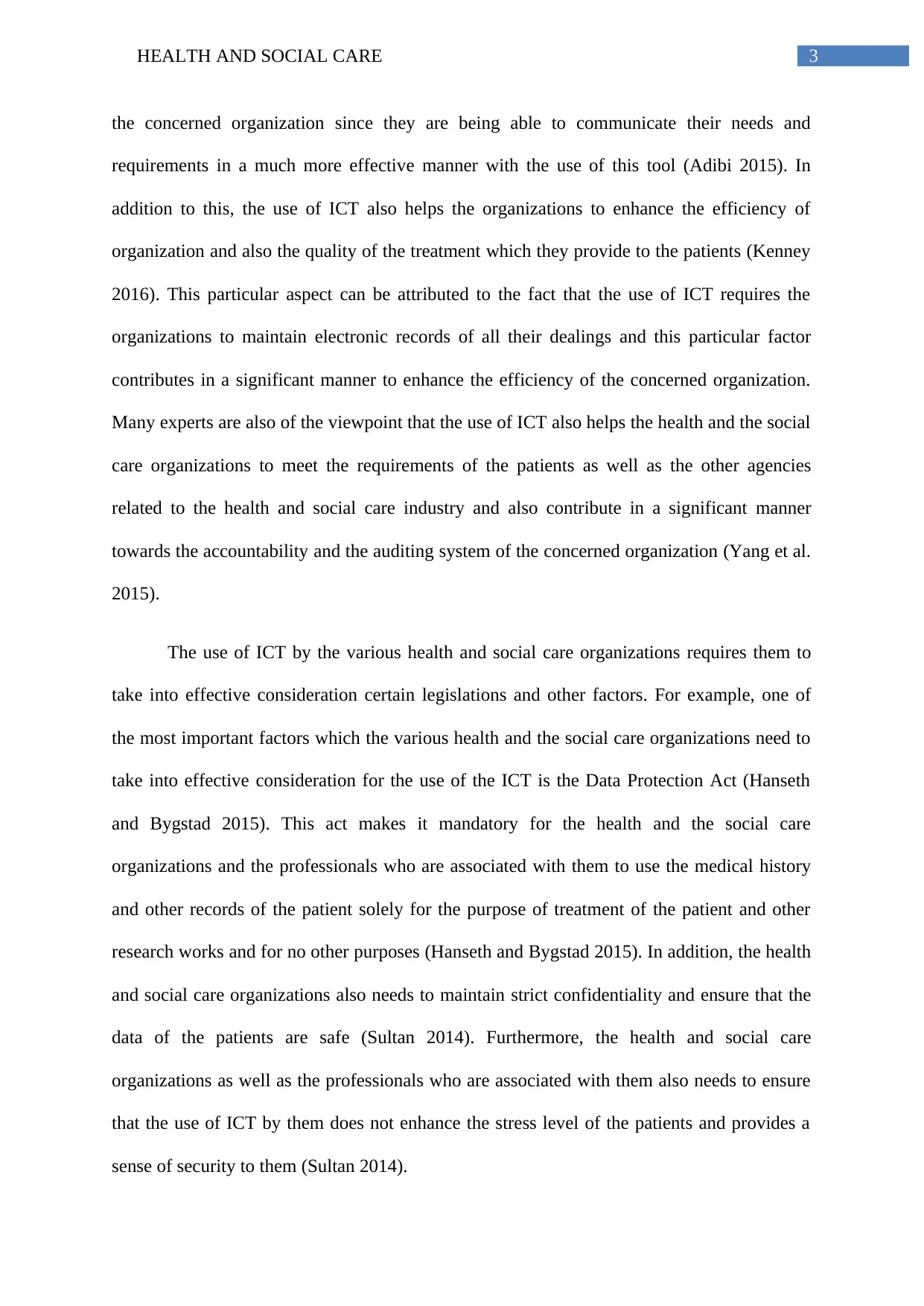
3HEALTH AND SOCIAL CARE
the concerned organization since they are being able to communicate their needs and
requirements in a much more effective manner with the use of this tool (Adibi 2015). In
addition to this, the use of ICT also helps the organizations to enhance the efficiency of
organization and also the quality of the treatment which they provide to the patients (Kenney
2016). This particular aspect can be attributed to the fact that the use of ICT requires the
organizations to maintain electronic records of all their dealings and this particular factor
contributes in a significant manner to enhance the efficiency of the concerned organization.
Many experts are also of the viewpoint that the use of ICT also helps the health and the social
care organizations to meet the requirements of the patients as well as the other agencies
related to the health and social care industry and also contribute in a significant manner
towards the accountability and the auditing system of the concerned organization (Yang et al.
2015).
The use of ICT by the various health and social care organizations requires them to
take into effective consideration certain legislations and other factors. For example, one of
the most important factors which the various health and the social care organizations need to
take into effective consideration for the use of the ICT is the Data Protection Act (Hanseth
and Bygstad 2015). This act makes it mandatory for the health and the social care
organizations and the professionals who are associated with them to use the medical history
and other records of the patient solely for the purpose of treatment of the patient and other
research works and for no other purposes (Hanseth and Bygstad 2015). In addition, the health
and social care organizations also needs to maintain strict confidentiality and ensure that the
data of the patients are safe (Sultan 2014). Furthermore, the health and social care
organizations as well as the professionals who are associated with them also needs to ensure
that the use of ICT by them does not enhance the stress level of the patients and provides a
sense of security to them (Sultan 2014).
the concerned organization since they are being able to communicate their needs and
requirements in a much more effective manner with the use of this tool (Adibi 2015). In
addition to this, the use of ICT also helps the organizations to enhance the efficiency of
organization and also the quality of the treatment which they provide to the patients (Kenney
2016). This particular aspect can be attributed to the fact that the use of ICT requires the
organizations to maintain electronic records of all their dealings and this particular factor
contributes in a significant manner to enhance the efficiency of the concerned organization.
Many experts are also of the viewpoint that the use of ICT also helps the health and the social
care organizations to meet the requirements of the patients as well as the other agencies
related to the health and social care industry and also contribute in a significant manner
towards the accountability and the auditing system of the concerned organization (Yang et al.
2015).
The use of ICT by the various health and social care organizations requires them to
take into effective consideration certain legislations and other factors. For example, one of
the most important factors which the various health and the social care organizations need to
take into effective consideration for the use of the ICT is the Data Protection Act (Hanseth
and Bygstad 2015). This act makes it mandatory for the health and the social care
organizations and the professionals who are associated with them to use the medical history
and other records of the patient solely for the purpose of treatment of the patient and other
research works and for no other purposes (Hanseth and Bygstad 2015). In addition, the health
and social care organizations also needs to maintain strict confidentiality and ensure that the
data of the patients are safe (Sultan 2014). Furthermore, the health and social care
organizations as well as the professionals who are associated with them also needs to ensure
that the use of ICT by them does not enhance the stress level of the patients and provides a
sense of security to them (Sultan 2014).
Paraphrase This Document
Need a fresh take? Get an instant paraphrase of this document with our AI Paraphraser
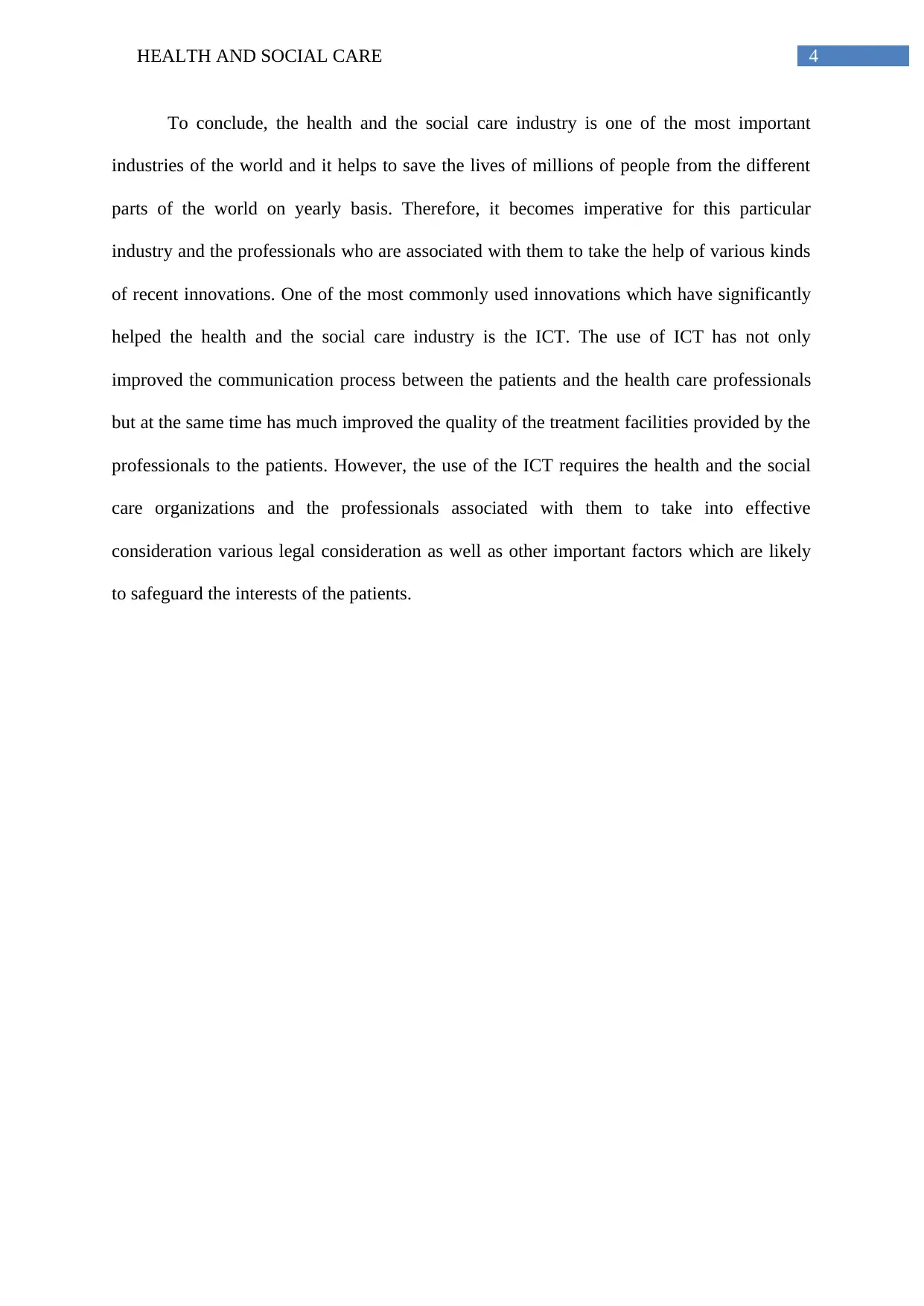
4HEALTH AND SOCIAL CARE
To conclude, the health and the social care industry is one of the most important
industries of the world and it helps to save the lives of millions of people from the different
parts of the world on yearly basis. Therefore, it becomes imperative for this particular
industry and the professionals who are associated with them to take the help of various kinds
of recent innovations. One of the most commonly used innovations which have significantly
helped the health and the social care industry is the ICT. The use of ICT has not only
improved the communication process between the patients and the health care professionals
but at the same time has much improved the quality of the treatment facilities provided by the
professionals to the patients. However, the use of the ICT requires the health and the social
care organizations and the professionals associated with them to take into effective
consideration various legal consideration as well as other important factors which are likely
to safeguard the interests of the patients.
To conclude, the health and the social care industry is one of the most important
industries of the world and it helps to save the lives of millions of people from the different
parts of the world on yearly basis. Therefore, it becomes imperative for this particular
industry and the professionals who are associated with them to take the help of various kinds
of recent innovations. One of the most commonly used innovations which have significantly
helped the health and the social care industry is the ICT. The use of ICT has not only
improved the communication process between the patients and the health care professionals
but at the same time has much improved the quality of the treatment facilities provided by the
professionals to the patients. However, the use of the ICT requires the health and the social
care organizations and the professionals associated with them to take into effective
consideration various legal consideration as well as other important factors which are likely
to safeguard the interests of the patients.
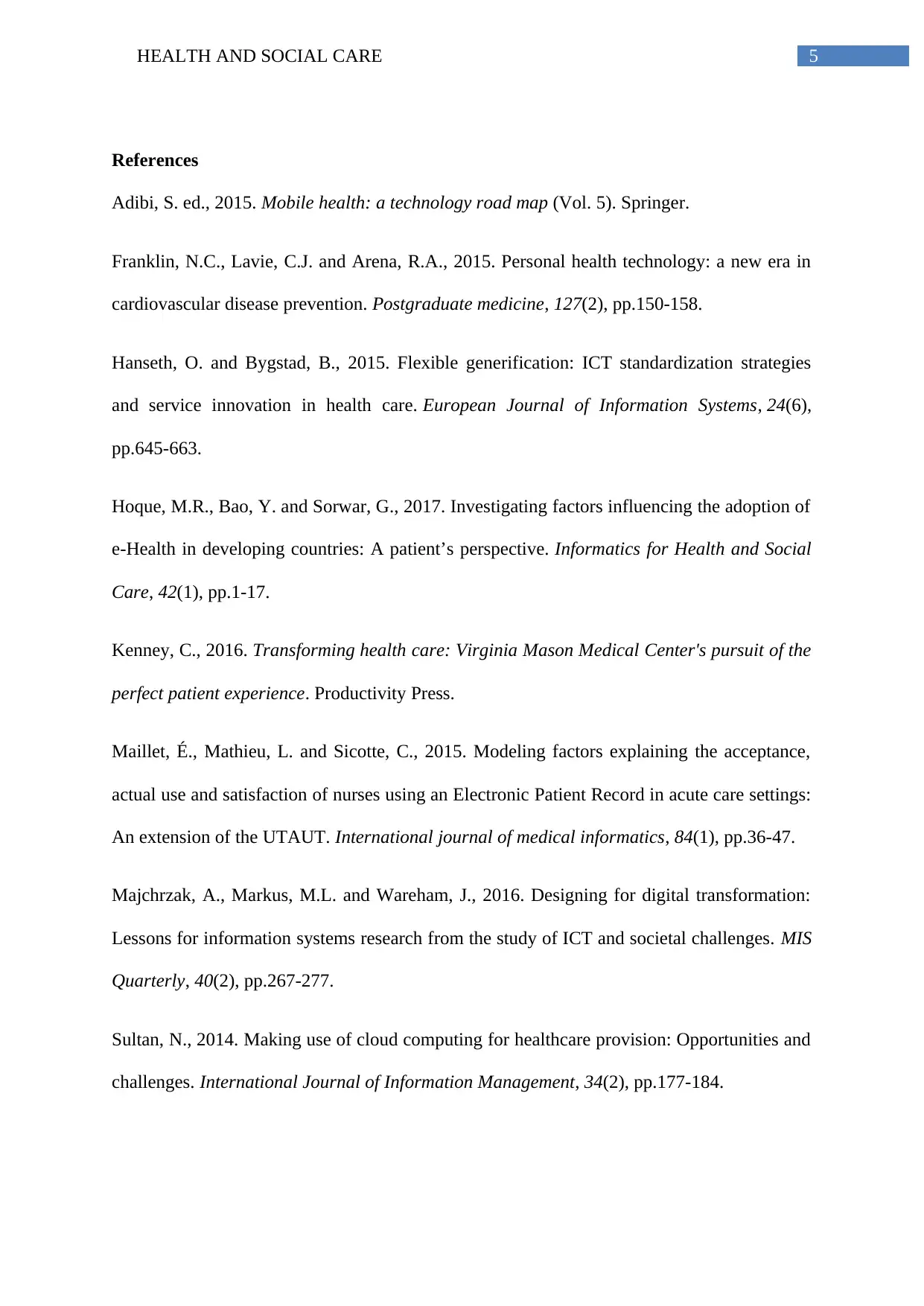
5HEALTH AND SOCIAL CARE
References
Adibi, S. ed., 2015. Mobile health: a technology road map (Vol. 5). Springer.
Franklin, N.C., Lavie, C.J. and Arena, R.A., 2015. Personal health technology: a new era in
cardiovascular disease prevention. Postgraduate medicine, 127(2), pp.150-158.
Hanseth, O. and Bygstad, B., 2015. Flexible generification: ICT standardization strategies
and service innovation in health care. European Journal of Information Systems, 24(6),
pp.645-663.
Hoque, M.R., Bao, Y. and Sorwar, G., 2017. Investigating factors influencing the adoption of
e-Health in developing countries: A patient’s perspective. Informatics for Health and Social
Care, 42(1), pp.1-17.
Kenney, C., 2016. Transforming health care: Virginia Mason Medical Center's pursuit of the
perfect patient experience. Productivity Press.
Maillet, É., Mathieu, L. and Sicotte, C., 2015. Modeling factors explaining the acceptance,
actual use and satisfaction of nurses using an Electronic Patient Record in acute care settings:
An extension of the UTAUT. International journal of medical informatics, 84(1), pp.36-47.
Majchrzak, A., Markus, M.L. and Wareham, J., 2016. Designing for digital transformation:
Lessons for information systems research from the study of ICT and societal challenges. MIS
Quarterly, 40(2), pp.267-277.
Sultan, N., 2014. Making use of cloud computing for healthcare provision: Opportunities and
challenges. International Journal of Information Management, 34(2), pp.177-184.
References
Adibi, S. ed., 2015. Mobile health: a technology road map (Vol. 5). Springer.
Franklin, N.C., Lavie, C.J. and Arena, R.A., 2015. Personal health technology: a new era in
cardiovascular disease prevention. Postgraduate medicine, 127(2), pp.150-158.
Hanseth, O. and Bygstad, B., 2015. Flexible generification: ICT standardization strategies
and service innovation in health care. European Journal of Information Systems, 24(6),
pp.645-663.
Hoque, M.R., Bao, Y. and Sorwar, G., 2017. Investigating factors influencing the adoption of
e-Health in developing countries: A patient’s perspective. Informatics for Health and Social
Care, 42(1), pp.1-17.
Kenney, C., 2016. Transforming health care: Virginia Mason Medical Center's pursuit of the
perfect patient experience. Productivity Press.
Maillet, É., Mathieu, L. and Sicotte, C., 2015. Modeling factors explaining the acceptance,
actual use and satisfaction of nurses using an Electronic Patient Record in acute care settings:
An extension of the UTAUT. International journal of medical informatics, 84(1), pp.36-47.
Majchrzak, A., Markus, M.L. and Wareham, J., 2016. Designing for digital transformation:
Lessons for information systems research from the study of ICT and societal challenges. MIS
Quarterly, 40(2), pp.267-277.
Sultan, N., 2014. Making use of cloud computing for healthcare provision: Opportunities and
challenges. International Journal of Information Management, 34(2), pp.177-184.
⊘ This is a preview!⊘
Do you want full access?
Subscribe today to unlock all pages.

Trusted by 1+ million students worldwide
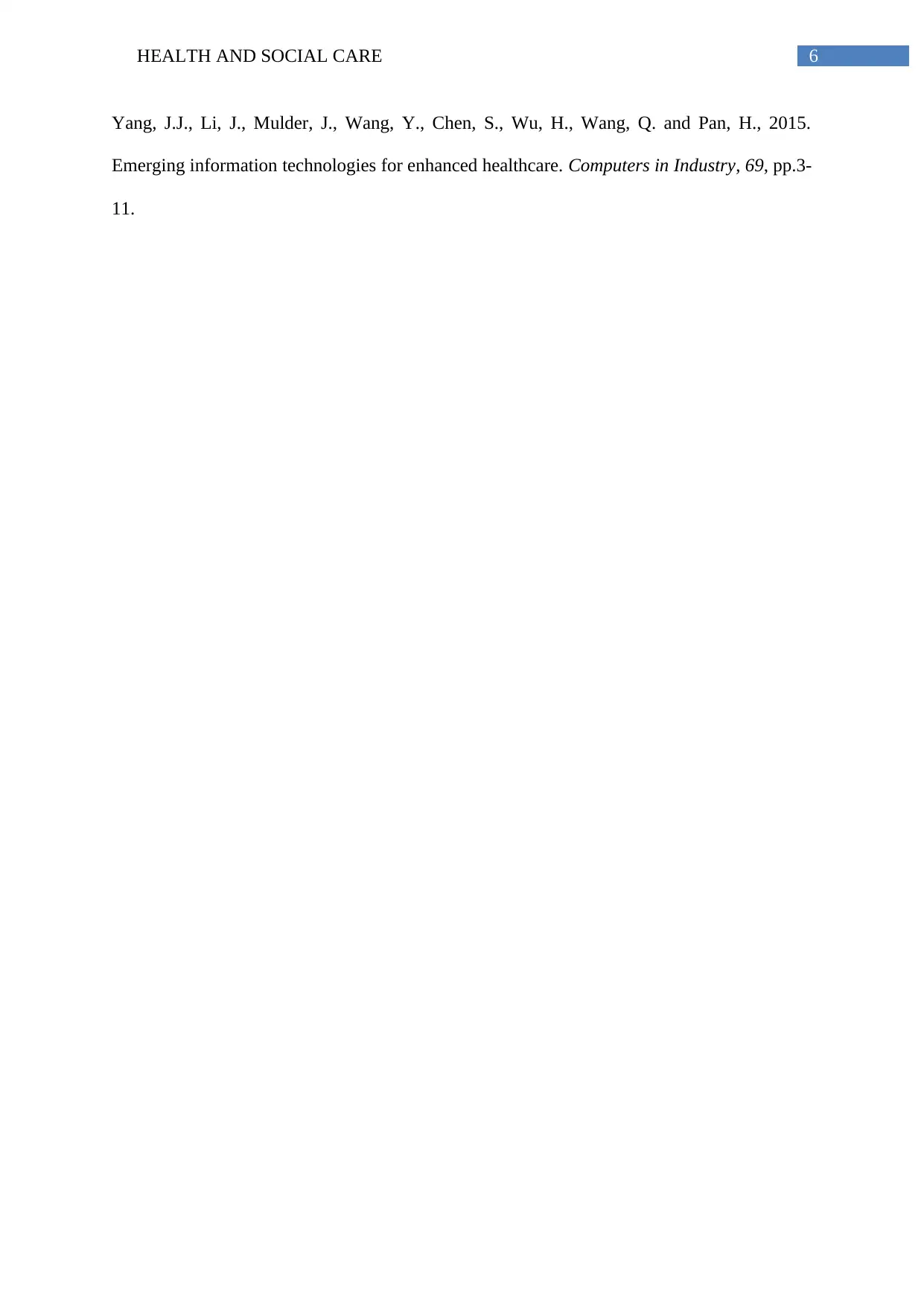
6HEALTH AND SOCIAL CARE
Yang, J.J., Li, J., Mulder, J., Wang, Y., Chen, S., Wu, H., Wang, Q. and Pan, H., 2015.
Emerging information technologies for enhanced healthcare. Computers in Industry, 69, pp.3-
11.
Yang, J.J., Li, J., Mulder, J., Wang, Y., Chen, S., Wu, H., Wang, Q. and Pan, H., 2015.
Emerging information technologies for enhanced healthcare. Computers in Industry, 69, pp.3-
11.
1 out of 7
Related Documents
Your All-in-One AI-Powered Toolkit for Academic Success.
+13062052269
info@desklib.com
Available 24*7 on WhatsApp / Email
![[object Object]](/_next/static/media/star-bottom.7253800d.svg)
Unlock your academic potential
Copyright © 2020–2025 A2Z Services. All Rights Reserved. Developed and managed by ZUCOL.





